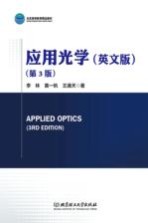

应用光学 第3版 英文版PDF电子书下载
- 电子书积分:11 积分如何计算积分?
- 作 者:李林
- 出 版 社:北京:北京理工大学出版社
- 出版年份:2018
- ISBN:9787568259217
- 页数:260 页
Chapter 1 Basic Principles of Geometrical Optics 1
1.1 Waves and Rays 1
1.2 Basic Laws of Geometrical Optics 4
1.3 Refractive Index and Speed of Light 5
1.4 Reversibility of Ray Paths and Total Internal Reflection 6
1.5 Vector Form of Basic Laws 9
1.6 Classification of Optical Systems and Concept of Imaging 10
1.7 Ideal Images and Ideal Optical Systems 13
Chapter 2 Image Formation of Symmetrical Systems Made from Spherical Surfaces 17
2.1 Ray Tracing Formulae for Symmetrical Systems Made from Spherical Surfaces 17
2.2 Sign Conventions 19
2.3 Imaging Characters and Ray Tracing in the Paraxial Region 21
2.4 Basic Formulae of the Paraxial Region 23
2.5 Cardinal Points of an Optical System 26
2.6 Principal Planes and Focal Points of a Single Refracting Surface 29
2.7 Principal Planes and Focal Points of a Coaxial Spheric System 30
2.8 Chart Illustration for Image Formation 32
2.9 Image Positions and Sizes 34
2.10 Magnifications of Optical Systems 37
2.11 The Optical Invariant 40
2.12 Relationship Between the Front and Back Effective Focal Lengths 41
2.13 Nodal Planes and Nodal Points 43
2.14 Image Height of the Object at Infinity 45
2.15 Combination of Ideal Optical Systems 46
2.16 Ray Tracing for Ideal Optical Systems 49
2.17 Equations for Calculating the Positions of the Principal Planes and Focal Points of a Single Lens 52
Chapter 3 Instruments for Human Eyes 58
3.1 Characteristics of the Eye 58
3.2 Principles of the Magnifier and the Microscope 62
3.3 Principle of the Telescope 66
3.4 Defects of Eyes and Diopter Accommodation of Optical Instruments 69
3.5 Spatial Depth of Focus and Stereoscopic Effect 71
3.6 Binocular Instruments 73
Chapter 4 Mirror and Prism Systems 77
4.1 Applications of Mirror and Prism Systems in Optical Instruments 77
4.2 Imaging Properties of Mirrors 78
4.3 Rotation of Mirrors 80
4.4 Prism and Its Unfolding 81
4.5 Roof Surfaces and Roof Prisms 86
4.6 Imaging Properties of the Parallel Glass Block and Prism Size Calculation 88
4.7 Determination of Image Orientations for Mirrors and Prisms 92
4.8 Combination of the Coaxial System and the Mirror and Prism System 96
4.9 Prism Rotation Law 97
Chapter 5 Selection of Image Rays in Optical Systems 103
5.1 Stop and Its Application 103
5.2 Selection of Imaging Rays in Telescope Systems 104
5.3 Selection of Imaging Rays in the Microscope and Telecentric System 111
5.4 Field Lenses 115
5.5 Depth of Field 116
5.6 Cold Stop Efficiency of Infrared Optical System 119
Chapter 6 Basics of Radiometry and Photometry 122
6.1 Solid Angle and Its Applications in Photometry 122
6.2 Basic Ideas in Radiometry 123
6.3 Relative Sensitivity of the Eye to Different Wavelengths 125
6.4 Basic Ideas in Photometry 127
6.5 Illuminance Formula and the Cosine Law of Luminous Intensity 133
6.6 Luminance of the Perfect Diffusive Surface 135
6.7 Luminance of the Light Beam in Optical Systems 136
6.8 Illuminance of the Image Plane 139
6.9 Illuminance and F Number of the Image Plane of the Camera Lens 141
6.10 Subjective Brightness of Human Eyes 143
6.11 Subjective Brightness when We Observe Through a Telescope 145
6.12 Calculation of Light Energy Loss in Optical Systems 147
Chapter 7 Image Quality of Optical Systems 153
7.1 Introduction 153
7.2 Color Dispersion and Chromatic Aberrations 154
7.3 The Axial Monochromatic Aberration—Spherical Aberration 156
7.4 Off-axial Monochromatic Aberrations 158
7.5 Aberration Curves 164
7.6 Wavefront Aberrations 168
7.7 Resolutions of Ideal Systems 170
7.8 Resolutions of Typical Systems 172
7.9 Optical Transfer Function 174
7.10 Application of Optical Transfer Function 178
7.11 Spot Diagrams 181
7.12 Encircled Energy 183
7.13 A Typical Example of Imaging Quality Evaluation of an Optical System 184
Chapter 8 Telescopes and Microscopes 193
8.1 Optical Performances of Telescopes 193
8.2 Objectives of Telescopes 198
8.3 Eyepieces of Telescopes 204
8.4 Introduction of Microscopes and Their Properties 208
8.5 Objectives and Eyepieces of Microscopes 211
Chapter 9 Cameras and Projectors 215
9.1 Characteristics of the Camera Lens 215
9.2 Typical Camera Lenses 217
9.3 Typical Projectors 220
9.4 Illumination Systems in Projectors 221
9.5 Projector Lenses 223
9.6 Energy Calculation of Projectors 226
Chapter 10 Other Optical Systems 230
10.1 Laser Optical Systems 230
10.2 Optical Information Processing Systems and Fourier-transform Lenses 239
10.3 Infrared Optical Systems 242
Vocabulary 251
Bibliography 259
- 《钒产业技术及应用》高峰,彭清静,华骏主编 2019
- 《现代水泥技术发展与应用论文集》天津水泥工业设计研究院有限公司编 2019
- 《英汉翻译理论的多维阐释及应用剖析》常瑞娟著 2019
- 《数据库技术与应用 Access 2010 微课版 第2版》刘卫国主编 2020
- 《区块链DAPP开发入门、代码实现、场景应用》李万胜著 2019
- 《虚拟流域环境理论技术研究与应用》冶运涛蒋云钟梁犁丽曹引等编著 2019
- 《卓有成效的管理者 中英文双语版》(美)彼得·德鲁克许是祥译;那国毅审校 2019
- 《当代翻译美学的理论诠释与应用解读》宁建庚著 2019
- 《第一性原理方法及应用》李青坤著 2019
- 《中学物理奥赛辅导:热学 光学 近代物理学》崔宏滨 2012
- 《大学计算机实验指导及习题解答》曹成志,宋长龙 2019
- 《指向核心素养 北京十一学校名师教学设计 英语 七年级 上 配人教版》周志英总主编 2019
- 《大学生心理健康与人生发展》王琳责任编辑;(中国)肖宇 2019
- 《大学英语四级考试全真试题 标准模拟 四级》汪开虎主编 2012
- 《大学英语教学的跨文化交际视角研究与创新发展》许丽云,刘枫,尚利明著 2020
- 《北京生态环境保护》《北京环境保护丛书》编委会编著 2018
- 《复旦大学新闻学院教授学术丛书 新闻实务随想录》刘海贵 2019
- 《大学英语综合教程 1》王佃春,骆敏主编 2015
- 《大学物理简明教程 下 第2版》施卫主编 2020
- 《指向核心素养 北京十一学校名师教学设计 英语 九年级 上 配人教版》周志英总主编 2019
